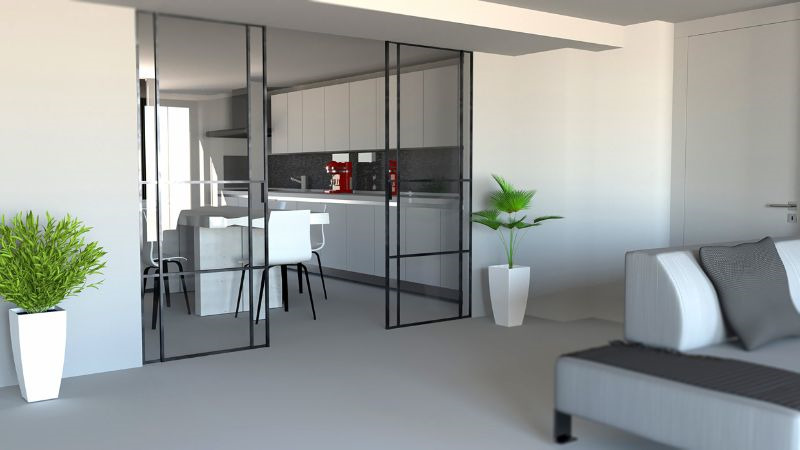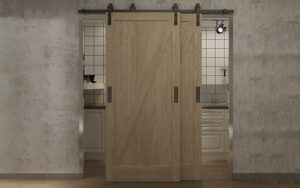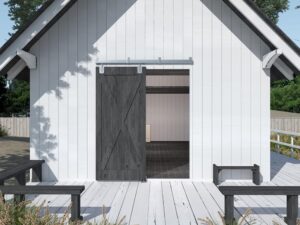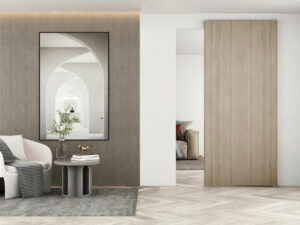You’ve probably seen barn doors on home renovation shows or in design magazines, but what exactly is a barn door, and what makes it so popular? Let’s find out!

Definition of a Barn Door
A barn door is a type of sliding door. Unlike traditional swinging doors that are attached to the doorframe with hinges, a barn door hangs from a track mounted above the doorway and slides horizontally to open and close. This simple yet effective mechanism is what gives the barn door its unique character and functionality.
Brief History of Barn Doors
As the name suggests, barn doors originated on farms and in agricultural settings. Their history can be traced back to the 1700s, where they served a purely practical purpose. These large, sturdy doors were designed to be wide enough to allow for the easy passage of livestock, wagons, and large farm equipment. Early barn doors were often built from readily available wood, with classic “X” and “Z” bracing patterns added for strength and stability. While the concept of large sliding doors is centuries old, the idea of using them inside the home is a more recent trend that has gained immense popularity.
5 Types of Barn Doors
While we often picture the classic sliding “farmhouse” door, there’s a whole world of barn doors out there. They primarily differ by their mechanism and the materials they’re made from.
1. Single Barn Doors
The most basic barn door style consists of a single panel that slides open and closed on tracks mounted above the doorway. Single doors work well for smaller openings but don’t provide as much privacy or insulation as double doors.
2. Double Barn Doors
For larger doorways, double barn doors are a popular choice. They are made up of two panels mounted on separate overlapping tracks. When closed, double doors create a more robust barrier than singles. They also add visual interest with their symmetrical two-panel design.
3. Bifold Barn Doors
Rather than sliding horizontally, bifold barn doors fold open by splitting vertically down the middle like an accordion door. This style saves space by only requiring a narrow track overhead when open. However, bifolds tend to be more expensive than sliding panel doors.
4. Glass Pane Barn Doors
For letting in natural light while maintaining privacy, glass barn doors are a modern option. They allow you to see into or out of a room without the door being fully open. Glass panels are often used in combination with solid wood sections for visual balance.
5. Decorative Barn Doors
Some barn door styles focus more on aesthetic details rather than function alone. Decorative doors may have intricate carved designs, colored panels, or hardware enhancements for an attractive focal point. These stylistic doors often come at a higher price point.

The real variety comes from the materials used. Here’s a quick comparison:
|
Material
|
Look & Feel
|
Best For
|
Considerations
|
|---|---|---|---|
|
Wood
|
Warm, classic, rustic to modern. Can be painted, stained, or left natural.
|
Creating a cozy, traditional, or modern farmhouse look. Very versatile.
|
Solid wood can be heavy. It’s important that doors are built with engineered cores to prevent warping over time.
|
|
Metal
|
Sleek, industrial, modern. Often combined with glass or wood.
|
Industrial lofts, contemporary homes, and creating a bold statement.
|
Can be more expensive and may show fingerprints more easily depending on the finish.
|
|
Composite
|
Lightweight, durable, and often more budget-friendly. Can mimic the look of wood.
|
High-moisture areas like bathrooms or for those looking for a low-maintenance option.
|
May not have the same authentic feel or longevity as solid wood or metal.
|
Styles of the Barn Door
Rustic Styles
For that inviting feel, warm, and classic barn door, look no further than rustic-style barn doors. Often crafted from reclaimed wood, these doors embrace the charm of farmhouse style, featuring worn surfaces, weathered paint, and beautifully aged hardware. This option adds character and personality to any room – it’s great for those seeking a cozy, vintage vibe.
- Reclaimed wood: Using reclaimed barn wood adds authenticity and history to your door, giving it a unique story.
- Distressed finishes: A worn or chipped paint finish can lend a rugged, time-worn appearance to the door.
- Iron or rustic hardware: Incorporating black wrought-iron or vintage-looking hardware, such as handles and hinges, can enhance the rustic theme.
Modern Styles
If sleek and contemporary door style is more your type, modern barn doors offer clean lines, minimalist designs, and innovative materials. Glass, metal, or even vinyl can replace traditional wood to create a door that complements your modern décor.
- Metal door frames: Choose a door with a metal frame for an industrial or minimalist look.
- Smooth surfaces: Doors with flat-panel designs and crisp lines fit well in modern spaces.
- Bold colors: Don’t be afraid to go bold with a solid color or two-tone design for your barn door.
DIY Designs
For the hands-on homeowner, DIY projects allow you to personalize and create a barn door that perfectly captures your vision. With a few tools, some creativity, and a bit of elbow grease, you can craft a one-of-a-kind door for your space.
Consider these ideas:
- Repurposed materials: Try using old pallets, shutters, or corrugated metal sheets for a unique look.
- Chalkboard paint: Apply chalkboard paint to a flat-panel door, transforming it into a creative, functional messaging space.
- Mix and match: Combine various materials, colors, and textures to create a door that tells your personal design story.
Why Choose a Barn Door For Your Home
Barn doors offer a unique combination of aesthetic appeal and practical benefits.
Design Aesthetics
The most obvious feature of a barn door is its visual impact. A barn door can serve as a focal point in a room, adding texture, color, and style. Whether you’re aiming for a cozy, farmhouse feel or a sleek, minimalist look, there’s a barn door to match.
Functional Benefits
- Space-saving Solutions: Because they slide along the wall, barn doors don’t require the same “swing space” as traditional doors. This makes them an excellent choice for smaller rooms, tight hallways, or any area where you want to maximize usable floor space.
- Versatility in Home Decor: Barn doors are incredibly versatile. They can be used to close off a pantry, a laundry room, a home office, or a closet. They can also be used as a room divider to create a more flexible living space.
Customization Options
The beauty of barn doors lies in their endless customization options. You can choose the size, style, material, finish, and hardware to create a door that is truly unique to your home. From the type of wood to the style of the track and handles, every element can be tailored to your specific taste.
Installation of Barn Doors
Installing a barn door can be a rewarding DIY project. Here’s a general overview of what’s involved.
Tools and Materials Required
- Barn door and hardware kit (track, rollers, stops, etc.)
- Drill and drill bits
- Level
- Measuring tape
- Pencil
- Wrench or socket set
- Stud finder
- Header board (if needed)

Quick Step-by-Step Guide:
- Install a Header: First, locate the studs in your wall. You’ll need to securely mount a solid piece of wood (the header) to these studs above your doorway. This provides the necessary support for the track and door.
- Mount the Track: Carefully measure and mark the locations for your track on the header board. Use a level to ensure it’s perfectly straight, then drill and attach the track.
- Attach Hardware to the Door: Fasten the rollers (hangers) to the top of the door according to your kit’s instructions.
- Hang the Door: With a helper (these can be heavy!), carefully lift the door and place the rollers onto the track.
- Install Stops and Guides: Attach the stops at either end of the track to prevent the door from rolling off. Install the floor guide at the bottom to keep the door from swinging outward.
Common Mistakes to Avoid:
- Not installing a header board for proper support.
- Mounting the track on an unlevel line.
- Incorrectly measuring and buying a door that’s too small for the opening.
- Not accounting for enough clearance space on the wall for the door to slide.
Keeping Your Door in Top Shape
The good news is that barn doors are generally very durable. Here are a few tips for maintenance:
|
Task
|
How-To Guide
|
|---|---|
|
Cleaning
|
For wood doors, a simple dusting or wiping with a damp cloth is usually enough. For metal or glass, use a cleaner appropriate for that material. Periodically, wipe down the track and rollers to ensure a smooth glide.
|
|
Repairs
|
Minor scratches on wood can often be fixed with a touch-up pen. For deeper gouges, wood filler may be needed. Check the hardware periodically to ensure all bolts are tight.
|
|
Longevity
|
The key to a long-lasting barn door is quality construction. Doors built with an engineered lumber core are far more resistant to bowing or warping, ensuring your door will function properly for a lifetime .
|
Popular Uses of Barn Doors
Barn doors are no longer just for barns. They can be found in a wide variety of residential and commercial settings.

A. Residential Applications
- Pantry Doors: A barn door is a stylish way to close off a pantry.
- Closet Doors: Save space in a bedroom by using a barn door for the closet.
- Bathroom Doors: A barn door can add a touch of rustic luxury to a master bathroom.
- Room Dividers: Use a pair of barn doors to divide a large room into two smaller spaces.
B. Commercial Applications
- Office Doors: A barn door can add a modern and stylish touch to an office.
- Conference Room Doors: A large barn door can be used to close off a conference room.
- Restaurant and Retail Entrances: Barn doors can create a unique and inviting entrance for a restaurant or retail store.
C. Creative and Unique Uses
- Headboards: A reclaimed barn door can be used as a unique and rustic headboard.
- Wall Decor: A beautifully finished barn door can be hung on the wall as a piece of art.
- Covering a TV: Use a sliding barn door to hide a TV when it’s not in use.
Conclusion
Barn doors are a versatile and stylish design element that can add character and functionality to any space. They are a great space-saving solution and can be customized to fit any decor.
We hope this guide has inspired you in some way. If you have any questions or would like to learn more about our custom door options, please don’t hesitate to contact us.
Frequently Asked Questions (FAQs)
1. Do barn doors provide good privacy?
This is a great question. Because a sliding barn door hangs in front of an opening and doesn’t seal within a frame like a traditional door, it won’t offer the same level of sound or light insulation. For a bedroom or bathroom where privacy is key, you’ll want to ensure the door is at least 2 inches wider and 1 inch taller than your opening to minimize gaps. While they are great for many applications, for a space requiring total soundproofing, a traditional swing door might be better.
2. How much wall space do I need to install a barn door?
This is a crucial measurement! You need a clear section of wall next to your doorway that is at least as wide as the door itself. The door needs this space to slide completely open. Before you fall in love with a barn door, make sure to measure your wall to ensure you have enough clearance. Also, check for any obstructions like light switches, outlets, or artwork.
3. Are barn doors noisy to open and close?
Not if you have a quality system! Modern barn door hardware is designed for a quiet, smooth glide. High-quality nylon wheels and a well-installed track will be virtually silent. If you hear grinding or squeaking, it’s usually a sign of low-quality hardware or an improper installation.
4. Can I put a lock on a barn door?
Yes, you can! While you can’t use a traditional doorknob and lock set, there are several great locking options designed specifically for barn doors. The most common are teardrop-style privacy locks or hook-and-eye latches. These are simple to install and are perfect for adding privacy to a bathroom or bedroom.
5. Are barn doors just a trend, or are they here to stay?
While they have certainly been a hot trend, barn doors have proven their staying power. Their blend of timeless style and practical, space-saving function has cemented their place as a classic design element. They have evolved from a purely “farmhouse” look and are now used in all kinds of decor styles, from industrial to ultra-modern. The barn door isn’t just a trend; it’s a new classic.






